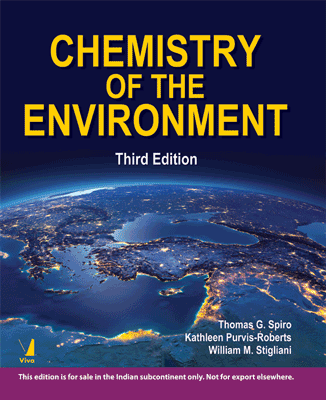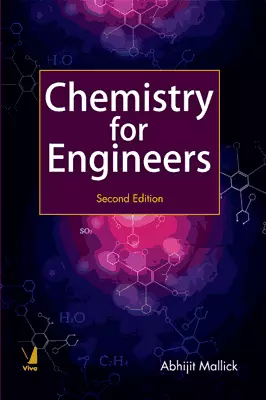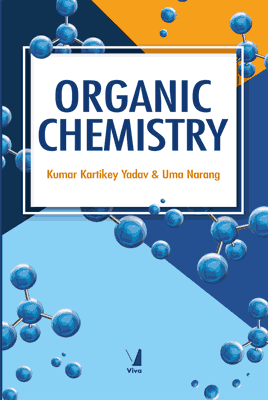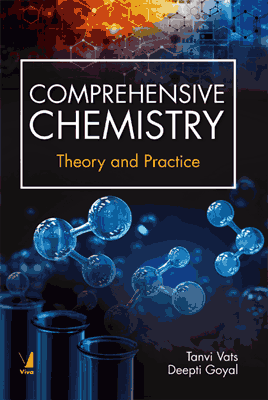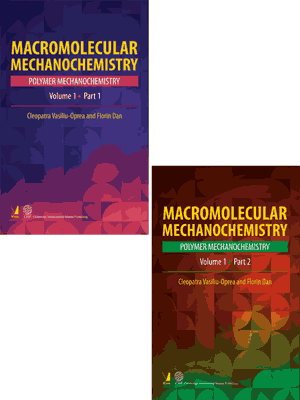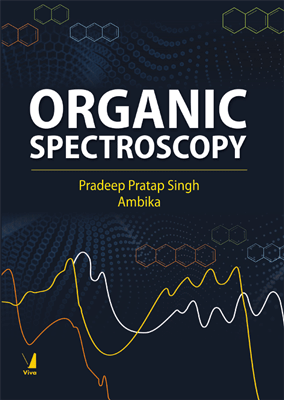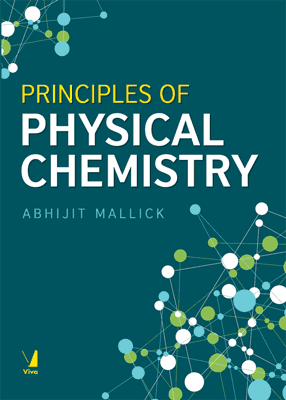Chemistry of the Environment, 3/e
Chemistry of the Environment, 3/e
₹895.50 ₹995.00 Save: ₹99.50 (10%)
Go to cartISBN: 9789386105257
Bind: Paperback
Year: 2017
Pages: 640
Size: 204 x 280 mm
Publisher: University Science Books
Published in India by: Viva Books
Exclusive Distributors: Viva Books
Sales Territory: India, Nepal, Pakistan, Bangladesh, Sri Lanka
Reviews:
"I very much congratulate the authors.This is by far the best environmental chemistry text that I have read."
Professor John Perona, University of California at Santa Barbara
"No other text in environmental chemistry so nicely balances breadth, depth and readability."
Professor A.D. Anbar, Arizona State University
Description:
Chemistry of the Environment, 3rd Edition, is a concise, clear and current account of today's environmental issues and the science one needs to understand them. This intermediate-level text, which recommends general chemistry as a prerequisite, systematically lays out themes of sustainability, atmosphere, hydrosphere, lithosphere and biospheres, while stressing the interconnectedness of environmental problems and solutions. The completely revised third edition explains the natural chemical cycles, and how humans affect them. It also analyzes strategies for ameliorating human impacts. This stimulating new text uses concise, straightforward language and an accessible narrative style to inform quantitative thinking.
Target Audience:
This book will be useful for students and academicians of chemistry, environment and environmental chemistry.
Contents:
Foreword by Harry Gray • Preface
Part I. Sustainability and Green Chemistry
Chapter 1: Sustainability and Chemistry? What is Sustainability? • From Environmentalism to Sustainability • Sustainability Connections among Environmental Spheres • Applying Sustainability • Additional Reading
Chapter 2: Green Chemistry • Sustainable Living through Chemistry • Green Chemistry Principles • Green Chemistry Examples • Eliminating Chlorofluorocarbons • Greener Solvents: Liquid and Supercritical Carbon Dioxide • Dry Cleaning • Cleaning Computer Chips • Biomass Plastics • Polylactic Acid • Cellulose • Paint • Replacing Chlorine • Biodegradable Chelating Agent • Reducing Toxic Metals • Yttrium Replaces Lead in Automobile Coatings • Removing Arsenic and Chromium from Pressure-Treated Wood • Atom Economy: Reducing Waste in Ibuprofen Manufacture • Materials Substitution: Recyclable Carpet • Environmentally Benign Pesticides • Problem • Additional Reading
Part II . Atmosphere
Chapter 3: Air Pollution • Pollutants and their Effects • Carbon Monoxide • Sulfur Dioxide • Sulfur Dioxide Emission Controls • Toxic Organics • Formaldehyde and Acetaldehyde • Benzene • Polycyclic Aromatic Hydrocarbons • Particulate Matter • Nitrogen Oxides and Volatile Organics • Ozone and Other Oxidants • Control of Ozone Precursors • Indoor Air Pollution • Problems • Additional Reading
Chapter 4: Nitrogen Oxides, Ozone, and Gasoline • Aerobic Earth • Nitrogen Oxides: Free Energy • Free Energy and Equilibrium • Worked Problem: Atmospheric NO Concentration • Free Energy and Temperature • Worked Problem: High-Temperature NO • Nitrogen Oxides: Kinetics • Free Radical Chain Reactions • Photochemistry • Photochemical Smog • Smog Photochemistry • The C???H Bond Strengths and Photochemical Activity • Role of Olefins • Atmospheric Reactions of Organic Radicals • Additional Smog Contributions • Gasoline and Its Formulations • Knocking and Octane • Diesels and Cetane • Lead in Gasoline • Reformulated Gasoline (RFG) • Problems • Additional Reading
Chapter 5: Stratospheric Ozone Shield • Overview • Structure of the Atmosphere • Worked Problem: How Much Ozone? • Ultraviolet Radiation Damage • Transmission of UV Light through Ozone • Reactions That Create and Destroy Stratospheric Ozone • Calculating the Ozone Steady State • Catalytic Destruction of Ozone • Hydroxyl Radical • Chlorine and Bromine • Nitric Oxide • Summary of Ozone Destruction Chemistry • Polar Ozone Destruction • Ozone Projections • The Chlorofluorocarbon Substitutes • Problems • Additional Reading
Chapter 6: Climate Change • Overview • Energy Flows • Radiation Balance and the Greenhouse Effect • Worked Problem: Human Energy and Earth's Temperature • Infrared Absorption by Greenhouse Gases: Molecular Vibrations • Worked Problem: Beer-Lambert Law and CO2 Saturation • Water: Positive Feedback, Latent Heat, and Energy Flows • Worked Problem: Energy in Rain • Greenhouse Computations: Radiative Forcing • Carbon Dioxide and the Carbon Cycle • Reservoirs, Flows, and Residence Times • Worked Problem: Carbon Residence Time • Other Greenhouse Gases • Albedo, Particles, and Clouds • Raindrops and Condensation Nuclei • Worked Problem: Cloud Seeding • Aerosol Particles • Worked Problem: Volcanic Cooling? Sulfur Cycle • Black Carbon • Geoengineering to Raise the Albedo • Climate Modeling • Global Warming Impacts • International Agreements • Problems • Additional Reading
Part III. Energy and Materials
Chapter 7: Energy Flows and Supplies • Human Energy Consumption • Exponential Growth • Worked Problem: World Energy Consumption • Human Energy Sources • Problems • Additional Reading
Chapter 8: Fossil Fuels • Closing the Carbon Cycle • Worked Problem: Will We Run Out of Oxygen? • Origins of Fossil Fuels • Petroleum and Natural Gas • Coal • Fuel Energy • Hydrogen Combustion and Bond Enthalpies • Comparison of Fuel Energies • Worked Problem: Methane Combustion • Petroleum • Composition and Refining • Advantages • Disadvantages • Oil Spills • Carbon Dioxide Emissions • When Will the Oil Run Out? • Gas • Advantages • Disadvantages • When Will the Gas Run Out? • Coal • Advantages • Disadvantages • When Will the Coal Run Out? • Coal-Derived Fuels • Carbon Capture and Storage • Capture • Geological Storage • Biological Storage • Problems • Additional Reading
Chapter 9: Nuclear Energy • Curve of Binding Energy • Nuclei, Isotopes, and Radioactivity • Half-Lives and Naturally Occurring Radioisotopes • Worked Problem: Radiocarbon Dating • Decay Chains: The Radon Problem • Radioactivity: Biological Effects of Ionizing Radiation • Alpha Rays • Beta and Gamma Rays, and Neutrons • Radiation Exposure • Worked Problem: Radon Exposure • Power from Fission • Fission Reactors • Isotope Separation • Breeder Reactor • Reprocessing • Hazards of Nuclear Power • Reactor Safety • Weapons Proliferation • Nuclear Waste Disposal • New Reactor Designs and the Thorium Fuel Cycle • The Future of Nuclear Power • Fusion • Fusion Reactions • Inertial Confinement • Magnetic Confinement • Is Fusion the Energy Source of the Future? • Problems • Additional Reading
Chapter 10: Renewable Energy • Forms of Renewable Energy • Solar Heating • Solar Electricity • Solar Thermal Electricity and Solar Chemical Processing • Photovoltaic Electricity • Principles of the Photovoltaic Cell • Photosynthesis and Photoelectrochemistry • Biomass • Ethanol from Biomass • Ethanol from Starch or Cellulose? • Biodiesel • Methane from Biomass • Hydroelectricity • Worked Problem • Wind Power • Ocean Energy • Tides • Waves • Salt Gradient • Thermal Gradients • Deep Ocean Current • Geothermal Energy • Problems • Additional Reading
Chapter 11: Energy Utilization • Efficiency and Heat: The Role of Entropy • Heat Engine Efficiencies • Worked Problem: Power Plant Efficiency • Energy to Heat: The Heat Pump • Chemical Energy: Fuel Cells • Worked Problem: Fuel Cell Efficiency • A PEM Fuel Cell • Other Fuel Cells • Microbial Fuel Cell • Space Heating, Cogeneration • Electricity Storage • Batteries • Hydrogen Storage • The Materials Connection • Materials Properties: Paper versus Plastics • Recycling • Energy of Refining Al versus Fe • Concrete • Dematerialization • Systems Efficiency • Industrial Ecology • Transportation • Energy Efficiency in Automobiles • The ?Smart Grid? • Hydrogen Economy • Connecting Energy Use and Climate Change: Stabilization Wedges and Cost Curves • Problems • Additional Reading
Part IV. Hydrosphere and Lithosphere
Chapter 12: Water Resources • Global Perspective • Irrigation • ?Virtual? Water and the Issue of Meat Production • Groundwater • United States Water Resources • The Oceans • Water as Solvent and as a Biological Medium • Problems • Additional Reading
Chapter 13: Water as Solvent: Acids and Bases? Unique Properties of Water • Hydrogen Bonding • Clathrates and Water Miscibility • Ions, Autoionization, and pH • The pH Scale • Weak Acids and Bases: Buffers • Weak Acids • The pH of a Weak Acid • Worked Problem: The pH of a Weak Acid • Weak Bases • The pH of a Weak Base • Worked Problem: The pH of a Weak Base • Conjugate Acids and Bases: Buffers • Water in the Atmosphere: Acid Rain • Polyprotic Acids • Worked Problem: Phosphate Protonation • Worked Problem: Ocean Carbonate • Alkalinity • Problems • Additional Reading
Chapter 14: Water and the Lithosphere? The Earth as an Acid-Base Reactor • Organic and Inorganic Carbon Cycles • The Carbonate Control Carbonate Sequestration • Carbon Dioxide, Water, and Earth's Planetary Neighbors • Weathering and Solubilization Mechanisms • Ionic Solids and the Solubility Product • Worked Problem: Barium Sulfate Solubility • Solubility and Basicity • Worked Problem: Calcium Carbonate Solubility in Equilibrium with the Atmosphere? Ocean Acidification • Ion Exchange: Clays and Humic Substances • Effects of Freshwater Acidification • Soil Neutralization • Hardness and Detergents • Acid Deposition and Watershed Buffering • Ecosystem Effects of Acid Rain • Acid Mine Drainage • Global Acidification • Problems • Additional Reading
Chapter 15: Oxygen and Life • Redox Reactions and Energy • Biological Oxygen Demand • Worked Problem: Biological Oxygen Demand • Oxidation Levels and Water • Worked Problem: Calculating the Oxidation State and Balancing Redox Equations • Reduction Potentials • Natural Sequence of Biological Reductions • Concentration Dependence of the Potential: pH and Eh • Worked Problem: Eh and Ksp of Fe(OH)3 • Worked Problem: Effective Oxygen Potential • Electron and Proton Affinities Are Linked: pE versus pH • Biological Oxidations • Aerobic Earth • Water as an Ecological Medium • The Euphotic Zone and the Biological Pump • Eutrophication in Freshwater Lakes • Nitrogen and Phosphorus: The Limiting Nutrients • Anoxia and Its Effects on Coastal Marine Waters • Wetlands as Chemical Sinks • Redox Effects on Metals Pollution • Fertilizing the Ocean with Iron • Problems • Additional Reading
Chapter 16: Water Pollution and Water Treatment • Water Use and Water Quality: Point and Nonpoint Sources of Pollution • Regulation of Water Quality • Water and Sewage Treatment • Desalinization of Seawater • Health Hazards • Pathogens and Disinfection • Organic and Inorganic Contaminants • Waste Sites • Agriculture • Low-Cost Water Technology for Developing Countries • Trace Pollutants • Perchlorate Pollution • Summary of Hydrosphere-Lithosphere Interactions • Problems • Additional Reading
Part V. Biosphere
Chapter 17: Nitrogen and Food Production • Nitrogen Cycle • Agriculture • Fertilizer and the Green Revolution • Environmental Degradation • Confined Animal Feeding Operations • Organic Farming and Sustainable Agriculture • Nutrition • Energy and Calories • Protein • Minerals and Vitamins • Antioxidants • Antioxidant Mechanisms • Problems • Additional Reading
Chapter 18: Pest Control • Insecticides • Persistent Insecticides: Organochlorines • Molecular Shape and Biological Activity • Ecosystem Effects: Bioaccumulation • Bioaccumulation and the Partition Coefficient • Nonpersistent Insecticides: Organophosphates and Carbamates • Molecular Mechanism of Cholinesterase Inhibitors • Natural Insecticides • Integrated Pest Management • Herbicides • Molecular Mechanism of Glyphosate Inhibition; Genetic Engineering • Genetically Modified Organisms • Genetically Modified Plants: Actualities and Potential • Resistance to Genetically Modified Foods • Moral Issues • Political Issues • Health and Environment Issues • Problems • Additional Reading
Chapter 19: Toxicity of Chemicals • Acute and Chronic Toxicity • Cancer • Mechanisms • Cancer Incidence and Testing • Hormonal Effects • Bisphenol A • Persistent Organic Pollutants: Dioxins and Polychlorinated Biphenyls • Dioxins and Furans • Toxicity • Paper Bleaching and Combustion Sources • Natural Sources? • Exposure • Polychlorinated Biphenyls • Polybrominated Diphenyl Ethers • Perfluorooctanoic Sulfonate • Global Transport • Toxic Metals • Mercury • Cadmium • Arsenic • Lead • Exposure • Bioavailability • Toxicity • Problems • Additional Reading
Appendices • Appendix A: Organic Structures • Hydrocarbons: Alkanes • Isomers • Rings • Worked Problem: Pentane Isomers • Unsaturated Hydrocarbons • Molecular Shape • Carbon Framework Representations • Worked Problem: Name Frameworks • Aromatic Compounds • Heteroatoms
Appendix B: Mathematical Fundamentals • Units and Conversions • Exponents • Metric Units • Energy Units • Exponent and Log Rules Review • Basic Rules of Exponents • Basic Rules of Logarithmic Functions • Base 10 and Base e Logarithms • Illustration Credits • Index
About the Authors:
Thomas G. Spiro is Professor of Chemistry at the University of Washington. He received the B.S. from UCLA and the Ph.D. from MIT, and did postdoctoral work in Copenhagen. He joined the faculty of Princeton University in 1963, and served as chair of the chemistry department from 1980 to 1989, relocating to the University of Washington in 2007. He is the recipient of the ICPP Eraldo Antonini Lifetime Achievement Award (2010), the ACS Award for Distinguished Service in the Advancement of Inorganic Chemistry (2004), Biophysical Society Founders Award (2004), the Wellcome Visiting Professorship in the Basic Medical Sciences, at the University of British Columbia (1999), and the Bomem-Michelson Award in Molecular Spectroscopy (1986).
Kathleen Purvis-Roberts is an Associate Professor of Chemistry at the Joint Science Department of Claremont McKenna, Pitzer and Scripps Colleges. She earned her B.S. from Westmont College and her Ph.D. from Princeton University, where she worked with Steven Bernasek. From there, she did her postdoctoral work at the National Center for Atmospheric Research in Boulder, Colorado. She joined the faculty of Claremont McKenna, Pitzer, and Scripps Colleges in 2001.
William M. Stigliani is Professor of Chemistry, and develops curricula and teaches sustainability courses at the University of Northern Iowa.
